Impressive, Most Impressive: Ford GT Horsepower, Top Speed Announced!

–
Two years ago, when Ford announced its 2017 GT, the company touted this second-generation supercar as having “one of the best power-to-weight ratios of any production car.” While we’re pretty sure Ford’s top tech officer Raj Nair didn’t mean power-to-wait ratio, filling in the missing info has taken ages.
–
We’ll cut the Blue Oval crew some slack because they’ve been busy with other matters, such as winning their class and earning respectable finishes with all four of the race cars campaigned at Le Mans last summer. Ford GTs also finished 1-2 at a pair of six-hour races in Japan and China.
–
The competition schedule resumes Thursday when the garages open for Daytona’s 24-hour endurance race, but Nair took a break from his frenzy to decode the “more than 600 horsepower” rating uttered for the GT’s twin-turbo 3.5-liter EcoBoost V-6 two years ago. The facts we’ve waited patiently to hear are 647 horsepower at 6250 rpm and a maximum 550 lb-ft of torque at 5900 rpm with 495 lb-ft available at 3500 rpm. The little engine that could redlines at 7000 rpm.
–
–
While the break from V-8 tradition disappoints some, a specific output of 185 horsepower per liter tops that of the Porsche 911 Turbo’s twin-turbo flat-six by a wide margin. Nair seems especially proud of Ford’s anti-lag strategy, which keeps the turbines spinning during shifts and lift-throttle moments for optimum response when accelerating out of a turn. The downside is guzzler-grade EPA mileage, but fuel bills are unlikely to discourage customers shopping in this category.
–
On the vital weight half of the power/weight equation, Nair reported a dry figure of 3054 pounds, while also stating that this falls between the GT’s primary competitors, the McLaren 675LT and the Ferrari 488GTB. On our scales, the McLaren weighed 2982 pounds and the Ferrari 3428 pounds. Allowing 200 pounds for fluids, this means a Ford GT ready to roll weighs approximately 3250 pounds, more than 200 pounds less than a Corvette Grand Sport.
–
Thanks to the GT’s tight, low-drag (Cd = 0.35 in top-speed mode) envelope and variable aerodynamics, terminal velocity is 216 mph, according to Nair, who says it was measured on the Nardò Ring in Italy. That tops any other car manufactured in North America (the GT hails from Canada) and should be enough to run with the hottest Europeans with the exceptions of Bugatti’s Chiron, the Koenigsegg Agera, the Lamborghini Aventador SV, and Pagani’s Huayra.
–
–
Testing the GT versus its key rivals on the 3.1-mile road course at Calabogie Motorsports Park in Ontario, Canada, yielded additional bragging rights. With veteran racer Scott Maxwell at the wheel of the GT, a McLaren 675LT, and a Ferrari 458 Speciale, the final pecking order—according to Nair—was: Ford GT, 2:09.8 (min:sec); McLaren, 2:10.9; Ferrari, 2:12.9.
–
We’d call that one-to-three-second advantage not too shabby, earning the GT an express pass to this year’s Lightning Lap competition at Virginia International Raceway.
–
- –
- 17 Things You Need to Know About the Ford GT Supercar
- U-S-A! U-S-A! Ford Steamrolls Its Class on Return to Le Mans
- Research Ford GT: News, Photos, Features, and More
–
–
–
–
Asked to fill in additional details, Nair and global performance director Dave Pericak offered no pricing insight beyond the $ 450,000 quoted previously. Thus far, they say, a total of seven Ford GTs have been completed at partner Multimatic’s manufacturing plant—two last year to satisfy the Le Mans sanctioning body’s requirements and five more this month. Our sources were hesitant to say how many had reached lucky customer hands so far but confirmed that the production plan to build 250 GTs per year is still in force.
–
While our dialogue with the Blue Oval boys was fruitful, this significant unknown remains: Which of you Ford GT early adopters would like to host our first test drive?
–

–
Car and Driver BlogCar and Driver Blog


